Lithobates catesbeianus Shaw, 1802

Phylum: Chordata Haeckel, 1874
Subphylum: Vertebrata J-B. Lamarck, 1801
Classe: Amphibia Gray 1825
Ordine: Anura Duméril, 1806
Famiglia: Ranidae Rafinesque, 1814
Genere: Lithobates Fitzinger, 1843
Italiano: Rana toro
English: American Bullfrog
Français: Ouaouaron, Wawaron, Grenouille mugissante, Grenouille-taureau
Deutsch: Amerikanischer Ochsenfrosch
Español: Rana toro
Descrizione
Il nome deriva dal suo particolare gracidio che può ricordare il muggito dei bovini. È uno dei più grossi anfibi, capace di raggiungere i 20 cm di lunghezza (zampe escluse). Si presenta molto simile alla rana verde comune. La distingue la presenza di una membrana timpanica molto grande ed evidente (soprattutto nel maschio) e una struttura corporea decisamente robusta. Le sue dimensioni davvero ragguardevoli hanno indotto l'uomo a ricercarla per cibarsene e a introdurla in altre località, prima fra tutte Cuba ove si è diffusa in modo tale da consentirne la caccia organizzata con ampio commercio. La rana toro è stata importata anche in Europa: in Italia si è acclimatata bene nelle vasta rete di fiumi, laghi e canali artificiali che circondano Mantova e nei dintorni di Pavia. L'aspetto negativo delle importazioni di questo anfibio è quello connesso alla sua nutrizione nel suo ambiente. Infatti si tratta di una specie molto vorace che dove si insedia diventa una vera calamità per la fauna stanziale in quanto divora tutto: topi, piccoli insettivori, grossi insetti e soprattutto pesci. È inserita nell'Elenco delle 100 specie aliene più dannose del mondo.
Diffusione
Originaria degli Stati Uniti orientali e di alcune zone del Canada.
Sinonimi
= Lithobates (Aquarana) catesbeianus Dubois, 2006 = Rana (Aquarana) catesbeiana Dubois, 1992 = Rana (Lithobates) catesbeiana Fouquette and Dubois, 2014 = Rana (Novirana, Aquarana) catesbeiana Hillis & Wilcox, 2005 = Rana (Rana) catesbeiana Boulenger, 1920 = Rana (Rana) catesbeiana Dubois, 1987 = Rana catesbeiana Shaw, 1802 = Rana catesbyana Cope, 1889 = Rana catesbyana Smith, 1978 = Rana catesbyana Werner, 1909 = Rana conspersa LeConte, 1855 = Rana mugicus Angel, 1947 = Rana mugiens Merrem, 1820 = Rana nantaiwuensis Hsü, 1930 = Rana pipiens Daudin, 1802 = Rana scapularis Harlan, 1826 = Rana taurina Cuvier, 1817.
Bibliografia
–IUCN SSC Amphibian Specialist Group (2015). "Lithobates catesbeianus". IUCN Red List of Threatened Species. 2015.
–Frost, Darrel (2011). "American Museum of Natural History: Amphibian Species of the World 5.5, an Online Reference". Herpetology. The American Museum of Natural History.
–Hillis, David M. (February 2007). "Constraints in naming parts of the Tree of Life". Molecular Phylogenetics and Evolution. 42 (2): 331-338.
–Hillis, David M.; Wilcox, Thomas P. (February 2005). "Phylogeny of the New World true frogs (Rana)". Molecular Phylogenetics and Evolution. 34 (2): 299-314.
–Yuan, Z.-Y.; et al. (2016). "Spatiotemporal diversification of the true frogs (genus Rana): A historical framework for a widely studied group of model organisms". Systematic Biology. 65 (5): 824-42.
–"Rana catesbeiana". Amphibiaweb.org.
–Feduccia, Alan (editor) (1985). Catesby's Birds of Colonial America. Chapel Hill, North Carolina: University of North Carolina Press. 208 pp.
–Knapp, W. W. (2008-05-28). "Bullfrog - Rana catesbeiana". The Frogs and Toads of Georgia.
–Cardini, F. (1974). Specializations of the Feeding Response of the Bullfrog, Rana catesbeiana, for the Capture of Prey Submerged in Water. M.S. Thesis, U. of Massachusetts, Amherst, MA.
–Lutz, G.; Avery, J. "Bullfrog Culture". Southern Regional Aquaculture Center.
–"ANIMAL BYTES- North American Bullfrog". Sea World.
–"Rana catesbeiana". Fisheries and Aquaculture Department.
–McKercher, Liz; Gregoire, Denise R. (2011-09-14). "Lithobates catesbeianus (Shaw, 1802)". Nonindigenous Aquatic Species. U.S. Geological Survey.
–Geoffrey Hammerson (2008). "Rana draytonii". IUCN Red List of Threatened Species. 2008.
–Crayon, John J. (2009-12-03). "Lithobates catesbeianus (=Rana catesbeiana) (amphibian)". Global Invasive Species Database. Invasive Species Specialist Group.
–Lu, Christine; Sopory, Ambika (2010-08-23). "Rana catesbeiana". AmphibiaWeb.
–Borzée, Amaël; Kosch, A. Tiffany; Kim, Miyeon; Jang, Yikweon (May 31, 2017). "Introduced bullfrogs are associated with increased Batrachochytrium dendrobatidis prevalence and reduced occurrence of Korean treefrogs". PLOS ONE. 12 (5).
–"List of Invasive Alien Species of Union concern - Environment - European Commission". ec.europa.eu.
–"REGULATION (EU) No 1143/2014 of the European parliament and of the council of 22 October 2014 on the prevention and management of the introduction and spread of invasive alien species".
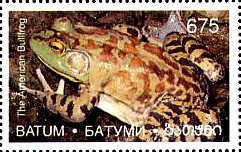
|
Data: 01/01/1997
Emissione: Rane Stato: Batum |
|---|
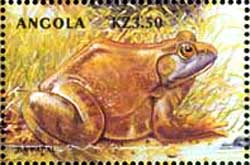
|
Data: 07/04/2000
Emissione: Animali del mondo Stato: Angola |
|---|
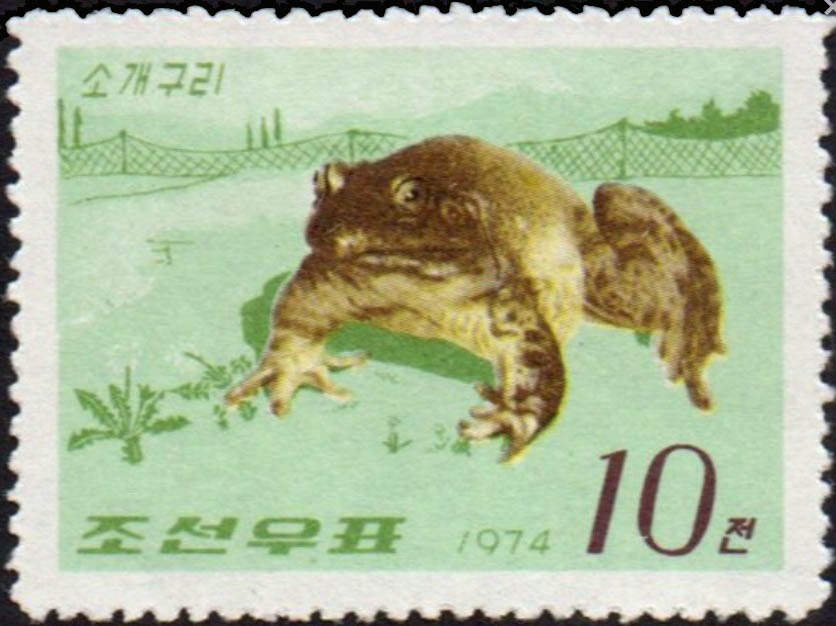
|
Data: 10/07/1974
Emissione: Anfibi Stato: Korea (North) |
|---|
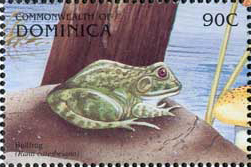
|
Data: 09/11/1999
Emissione: Rane Stato: Commonwealth of Dominica |
|---|

|
Data: 10/06/2002
Emissione: Rane Stato: Somalia |
|---|
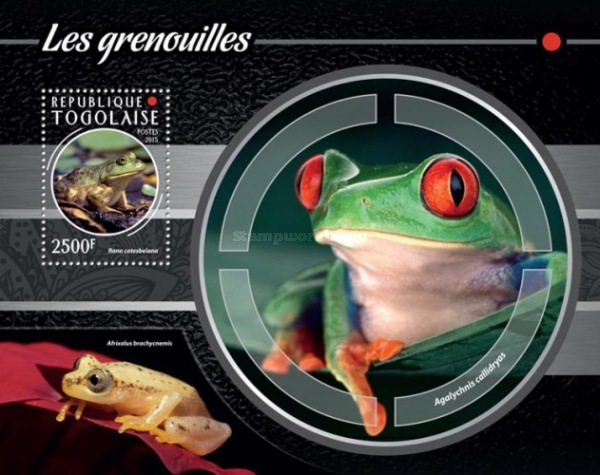
|
Data: 01/06/2015
Emissione: Rane delle foreste pluviali Stato: Togo |
|---|